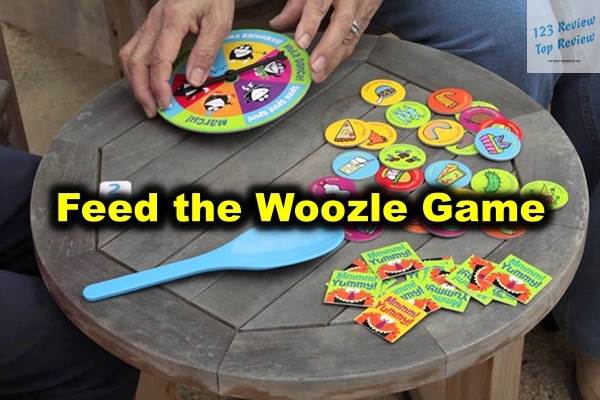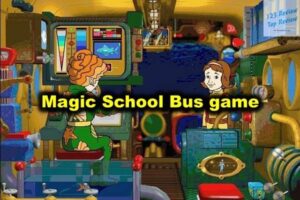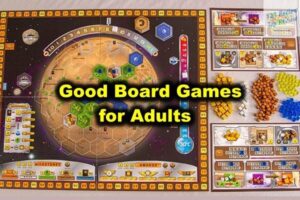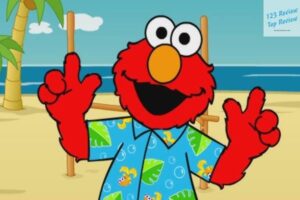“Feed the Woozle” is a whimsical, cooperative board game that has captivated young children and their families since its introduction. With its vibrant components, engaging gameplay, and educational benefits, it’s no wonder that this game has become a staple in homes, classrooms, and therapy settings. The game centers around feeding a silly, lovable monster named Woozle a variety of odd and humorous snacks while navigating different physical challenges. This blend of playfulness and skill-building has made “Feed the Woozle” a favorite among parents, educators, and therapists alike.
Game Overview
“Feed the Woozle” is a cooperative game designed to be enjoyed by young children, where the objective is to work together to feed the Woozle all his snacks before they topple off the spoon. The game combines elements of chance with physical activity, creating a fun and dynamic experience that also helps children develop important skills.

Target Age Group
The game is specifically designed for children aged 3 to 6 years old, making it accessible to preschoolers and kindergartners. The simplicity of the gameplay allows even the youngest players to grasp the basic concepts, while the varying levels of difficulty ensure that older children remain engaged. “Feed the Woozle” is an ideal game for this age group because it encourages cooperative play, physical activity, and the development of fine and gross motor skills—all while keeping the emphasis on fun.
Number of Players
“Feed the Woozle” is designed for 2 to 5 players, which makes it perfect for small group settings such as family game nights, playdates, or classroom activities. Because the game is cooperative rather than competitive, all players work together towards a common goal, creating a supportive environment where everyone can succeed. This feature also makes the game particularly suitable for children who may struggle with the pressures of competitive play, as it fosters a sense of shared accomplishment.
Game Components
The game comes with a variety of colorful and engaging components that are designed to appeal to young children. Each piece is crafted to be both durable and safe for little hands. The components include:
- Woozle Character Figure: The Woozle is a large, friendly monster with an oversized mouth that players aim to feed. The character’s whimsical design and bright colors are sure to capture the imagination of young players.
- Spinner: The spinner dictates the silly actions players must perform while carrying the snacks to the Woozle. These actions range from walking backward to hopping or spinning, adding an element of physical challenge and laughter to the game.
- Dice: The dice determine the number of snack tokens a player must carry to the Woozle. The simple act of rolling the dice and counting out the correct number of snacks helps children practice their counting skills.
- Spoon: The spoon is used to transport the snack tokens from the starting point to the Woozle. Balancing the snacks on the spoon without dropping them requires focus and coordination.
- Snack Tokens: The game includes 24 snack tokens, each featuring a different funny or whimsical food item, such as fuzzy donuts, hairy pickles, or chocolate-covered flies. These silly snacks add to the fun and encourage imaginative play.
- Instruction Guide: The guide provides clear instructions for setting up and playing the game. It also includes suggestions for adapting the game to different skill levels, making it easy for parents and educators to tailor the experience to the needs of the children playing.
Gameplay Mechanics
“Feed the Woozle” combines simple yet effective gameplay mechanics that keep children engaged while promoting a variety of developmental skills. The game’s design ensures that every aspect of play is not only entertaining but also educational.
Dice Rolling and Spinner Use
Each turn in “Feed the Woozle” begins with the player rolling the dice to determine how many snacks they need to deliver to the Woozle. The number on the dice ranges from 1 to 3, which keeps the counting simple and within the abilities of the target age group. This dice roll introduces an element of chance into the game, which adds excitement and unpredictability.
After rolling the dice, the player spins the spinner to determine how they must carry the snacks to the Woozle. The spinner has several different actions that the player might need to perform, such as:
- Walking Backward: The player must carefully navigate to the Woozle without being able to see where they are going.
- Spinning in Circles: The player has to turn around in circles while carrying the snacks, which can make keeping them balanced on the spoon a challenge.
- Hopping: The player must hop like a bunny while holding the spoon steady.
These silly actions are a key part of what makes “Feed the Woozle” so much fun for young children. They encourage physical activity, laughter, and an understanding of how different movements can affect balance and coordination.
Snack Feeding Process
Once the player has determined the number of snacks and the action they must perform, they load the corresponding number of snack tokens onto the spoon. The player then attempts to transport the snacks to the Woozle while performing the action indicated by the spinner.
This part of the game requires concentration, patience, and careful movement. The player must balance the snacks on the spoon and avoid dropping them as they move towards the Woozle. If the player successfully reaches the Woozle without dropping any snacks, they “feed” the Woozle by placing the snacks into its mouth. If they drop any snacks, those snacks do not get fed to the Woozle and must be left behind.
The snack feeding process is both challenging and rewarding. Children feel a sense of accomplishment when they successfully feed the Woozle, and the game’s cooperative nature means that everyone celebrates together when the Woozle is fully fed.
Levels of Play
One of the standout features of “Feed the Woozle” is its three distinct levels of play, which allow the game to grow with the child. Each level introduces new challenges and increases the complexity of the gameplay, ensuring that children remain engaged as their skills develop.
Level 1: Introduction to the Game
Level 1 is designed as an introduction to “Feed the Woozle” and is perfect for younger children or those who are new to the game. In this level, the focus is on simple snack feeding with minimal additional challenges. Players use the dice and spinner, but the actions required are straightforward and easy to execute.
The primary goal at this level is to help children become familiar with the basic mechanics of the game, such as rolling the dice, spinning the spinner, and balancing the snacks on the spoon. This level emphasizes learning through play and provides a gentle introduction to the game’s cooperative nature.
Level 2: Enhanced Challenges
As children become more comfortable with the basics, Level 2 introduces additional challenges that require greater concentration and coordination. The actions dictated by the spinner become more complex, and players may need to perform multiple tasks simultaneously, such as hopping while balancing snacks or spinning while walking.
This level helps children further develop their motor skills and encourages them to think more strategically about their movements. It also introduces the concept of adapting to new challenges, which is an important skill both in gameplay and in real-life situations.
Level 3: Advanced Play
Level 3 is designed for older children or those who have mastered the first two levels. This level combines all the game’s elements to create a more challenging and dynamic experience. Players must feed the Woozle more snacks while performing increasingly difficult actions, and the stakes are higher, as dropping snacks can have a greater impact on the outcome.
This advanced level is perfect for children who are ready for a more complex and engaging gameplay experience. It encourages them to apply all the skills they have developed in the earlier levels and work together even more closely as a team to achieve their goal.
Educational Benefits
“Feed the Woozle” is not only a source of entertainment but also a valuable educational tool. The game is designed to promote a range of developmental skills in young children, making it a favorite among parents, educators, and therapists.
Fine and Gross Motor Skills Development
One of the primary educational benefits of “Feed the Woozle” is its ability to help children develop both fine and gross motor skills. The game requires children to carefully balance snacks on a spoon while performing various physical actions, such as hopping, spinning, or walking backward.
- Fine Motor Skills: Balancing the snacks on the spoon and placing them into the Woozle’s mouth requires precision and control, helping children develop their fine motor skills. These skills are essential for tasks such as writing, drawing, and manipulating small objects.
- Gross Motor Skills: The physical actions dictated by the spinner help children develop their gross motor skills, including coordination, balance, and body awareness. These skills are important for physical activities such as running, jumping, and playing sports.
By engaging both fine and gross motor skills, “Feed the Woozle” provides a well-rounded physical activity that supports overall motor development in young children.
Counting and Body Awareness
“Feed the Woozle” also helps children develop their counting skills and body awareness. The simple act of rolling the dice and counting out the correct number of snacks provides practice in basic math skills, such as counting, number recognition, and one-to-one correspondence.
- Counting Skills: As children roll the dice and count out the snacks, they reinforce their understanding of numbers and quantities. This practice is particularly valuable for preschoolers who are just beginning to learn about numbers and counting.
- Body Awareness: The game’s emphasis on physical actions helps children become more aware of their bodies and how they move. For example, when a child is required to walk backward or spin in circles while balancing snacks, they must pay attention to their body’s movements and how those movements affect their balance.
These skills are essential for young children’s cognitive and physical development, and “Feed the Woozle” provides a fun and engaging way to practice them.
Teamwork and Cooperative Learning
One of the most significant educational benefits of “Feed the Woozle” is its emphasis on teamwork and cooperative learning. Because the game is cooperative rather than competitive, all players work together towards a common goal: feeding the Woozle. This collaborative approach teaches children the importance of working together, communicating effectively, and supporting each other.
- Teamwork: As players take turns feeding the Woozle, they must work together to ensure that all the snacks are delivered without falling off the spoon. This requires communication, coordination, and mutual support, all of which are important aspects of teamwork.
- Cooperative Learning: By working together to achieve a common goal, children learn that cooperation can lead to success. This lesson is valuable both in gameplay and in real-life situations, where teamwork and cooperation are often key to achieving positive outcomes.
“Feed the Woozle” provides a safe and supportive environment where children can practice these important social skills and learn the value of working together.
Game Reception
Since its release, “Feed the Woozle” has been widely praised by parents, educators, and therapists for its engaging gameplay and educational benefits. The game has received numerous awards and recognitions, as well as positive reviews from those who have played it.
Awards and Recognitions
“Feed the Woozle” has earned several awards and recognitions in the children’s gaming and educational communities. These accolades highlight the game’s success in combining entertainment with learning and its ability to engage young children in a meaningful way.
Some of the awards and recognitions that “Feed the Woozle” has received include:
- Parents’ Choice Award: This prestigious award recognizes products that are of the highest quality and that help children grow intellectually, emotionally, or physically.
- Oppenheim Toy Portfolio Platinum Award: This award is given to products that are innovative, educational, and fun. “Feed the Woozle” was recognized for its unique approach to cooperative play and skill development.
- Dr. Toy’s Best Classic Toys Award: “Feed the Woozle” was named one of Dr. Toy’s Best Classic Toys, a recognition given to toys that offer long-lasting play value and educational benefits.
These awards and recognitions underscore the game’s appeal to both children and adults, as well as its effectiveness as an educational tool.
Parental Reviews and Feedback
Parents who have purchased “Feed the Woozle” for their children often praise the game for its ability to keep kids entertained while also teaching them valuable skills. Reviews frequently mention the game’s durability, the creativity of the snacks and actions, and the joy it brings to family game nights.
- Durability: Parents appreciate the high quality of the game’s components, which are designed to withstand the rough and tumble of playtime with young children. The sturdy construction of the Woozle figure, spinner, dice, and snack tokens ensures that the game will last through many play sessions.
- Creative Design: The silly snacks and physical actions are often highlighted as one of the game’s most appealing features. Parents love how these elements engage their children’s imaginations and encourage them to be active and playful.
- Family Fun: Many parents report that “Feed the Woozle” has become a favorite during family game nights. The game’s cooperative nature makes it easy for everyone to participate, regardless of age or skill level, and the laughter and excitement that it generates are often mentioned in reviews.
Overall, parents are enthusiastic about “Feed the Woozle” and its ability to provide both entertainment and education for their children.
Therapeutic Uses
In addition to its popularity as a family game, “Feed the Woozle” has also found a place in therapy settings. Therapists have discovered that the game can be a useful tool in working with children who have developmental delays, motor skill challenges, or social difficulties.
- Developmental Therapy: The game’s focus on fine and gross motor skills makes it an excellent choice for developmental therapists who are helping children improve their coordination, balance, and control. The physical actions required by the spinner provide a fun and engaging way for children to practice these skills.
- Occupational Therapy: Occupational therapists have also used “Feed the Woozle” to help children develop the skills they need for daily living, such as hand-eye coordination, dexterity, and body awareness. The game’s cooperative nature encourages children to work together and communicate, which can be beneficial for those who struggle with social interactions.
- Speech Therapy: “Feed the Woozle” can be used in speech therapy to encourage communication and language development. As children take turns feeding the Woozle, they must talk to each other, explain their actions, and work together, all of which can help improve their verbal skills.
The therapeutic uses of “Feed the Woozle” demonstrate its versatility and effectiveness as both a game and an educational tool.
Comparisons with Similar Games
“Feed the Woozle” stands out in several ways when compared to other games aimed at young children. Its unique combination of cooperative gameplay, physical activity, and skill development sets it apart from other games in the same category.
Cooperative Games for Young Children
Unlike many traditional board games, “Feed the Woozle” is a cooperative game, meaning that all players work together rather than compete against each other. This cooperative approach is particularly beneficial for young children, as it fosters a sense of teamwork and shared success rather than rivalry or competition.
- Peaceable Kingdom Games: “Feed the Woozle” is part of a broader category of cooperative games produced by Peaceable Kingdom, a company known for its commitment to creating games that promote positive social interactions. Other popular cooperative games from Peaceable Kingdom include “Hoot Owl Hoot!” and “The Sneaky, Snacky Squirrel Game.” These games, like “Feed the Woozle,” encourage players to work together and develop important social skills.
- Other Cooperative Games: While there are other cooperative games available for young children, “Feed the Woozle” is unique in how it combines physical activity with learning. Its emphasis on motor skills, counting, and cooperative play sets it apart from other games that may focus solely on one area of development.
Overall, “Feed the Woozle” is an excellent choice for parents and educators looking for a cooperative game that provides both entertainment and educational value.
Skill-Building Games
“Feed the Woozle” is also part of a broader category of skill-building games designed to help young children develop important cognitive and physical skills. However, it stands out due to its unique combination of silliness and skill development.
- Motor Skills Games: There are many games on the market that focus on developing motor skills in young children. For example, “Don’t Spill the Beans” and “Elefun” both involve physical actions that require dexterity and coordination. However, “Feed the Woozle” differentiates itself by incorporating these physical challenges into a cooperative framework, making the game more engaging and supportive for children.
- Educational Games: Many educational games for young children focus on specific skills, such as counting, matching, or color recognition. “Feed the Woozle” integrates these educational elements into its gameplay, but it also adds a layer of physical activity and teamwork, making it a more holistic educational experience.
In summary, “Feed the Woozle” is a standout in the category of skill-building games due to its comprehensive approach to child development.
Purchasing and Availability
“Feed the Woozle” is widely available through various retail and online outlets, making it easy for parents and educators to add this fun and educational game to their collection.
Retail Availability
You can find “Feed the Woozle” in many toy stores, educational supply shops, and large retail chains that carry children’s games. The game is often stocked in the section for preschool games, alongside other educational toys and games. Retailers that commonly carry “Feed the Woozle” include:
- Target: Target stores often have a well-stocked selection of educational games, including “Feed the Woozle.”
- Walmart: Walmart is another retailer where you can find “Feed the Woozle,” either in-store or through their online platform.
- Specialty Toy Stores: Many specialty toy stores and educational supply shops carry “Feed the Woozle,” particularly those that focus on games and toys for young children.
Shopping in a physical store allows you to see the game in person, read the packaging, and perhaps even find other games that would complement your collection.
Online Purchase Options
For convenience, “Feed the Woozle” is also available through major online retailers, which makes it easy to purchase the game from the comfort of your home. Online platforms where you can find “Feed the Woozle” include:
- Amazon: Amazon offers “Feed the Woozle” with the convenience of fast shipping, customer reviews, and the option to purchase additional related products.
- Walmart.com: Walmart’s online store provides the option to purchase “Feed the Woozle” with home delivery or in-store pickup.
- Peaceable Kingdom’s Website: Purchasing directly from the publisher’s website may offer special deals or bundles with other games from the Peaceable Kingdom line.
Online shopping allows you to compare prices, read customer reviews, and ensure that you’re getting the best deal on the game.
Pricing Information
The price of “Feed the Woozle” typically ranges between $15 and $25, depending on the retailer and any current promotions. This price point makes the game an affordable option, especially given its educational value and the quality of its components.
- Sales and Discounts: Keep an eye out for sales and discounts, particularly around holidays or during back-to-school shopping periods. Retailers often offer promotions that can make “Feed the Woozle” even more budget-friendly.
- Used or Secondhand: If you’re looking for an even more affordable option, consider purchasing a used or secondhand copy of “Feed the Woozle.” Websites like eBay or local resale shops may have the game available at a reduced price.
Overall, “Feed the Woozle” offers excellent value for the price, given its durability, educational benefits, and the amount of fun it provides.
FAQs about Feed the Woozle Game
Parents and educators often have questions about “Feed the Woozle” before purchasing or playing the game. Here are some of the most common questions and answers, as well as tips for new players.
Common Questions from Parents
- Is “Feed the Woozle” suitable for children with special needs?
- Yes, “Feed the Woozle” is often used in therapy settings for children with developmental delays, motor skill challenges, or social difficulties. The game’s cooperative nature and physical activity can be beneficial for a wide range of children.
- How long does a typical game of “Feed the Woozle” last?
- A typical game lasts about 15 to 20 minutes, making it a quick and engaging activity that can hold the attention of young children.
- Can “Feed the Woozle” be played with fewer than 2 players?
- While the game is designed for 2 to 5 players, it is possible for a single child to play the game independently. The child can roll the dice, spin the spinner, and try to feed the Woozle on their own, practicing their motor skills and coordination.
- Is the game easy to set up and clean up?
- Yes, “Feed the Woozle” is easy to set up, with minimal components and simple instructions. Clean-up is also straightforward, as the game’s pieces are durable and easy to store in the box.
Tips for New Players
- Start with Level 1: If your child is new to the game, start with Level 1 to help them get familiar with the gameplay mechanics. Once they are comfortable, you can gradually introduce the more challenging levels.
- Encourage Creativity: The silly actions dictated by the spinner are meant to be fun and engaging. Encourage your child to be creative with their movements and have fun with the game.
- Focus on Teamwork: Remind your child that “Feed the Woozle” is a cooperative game, and the goal is to work together to feed the Woozle. Emphasize the importance of supporting each other and celebrating successes as a team.
“Feed the Woozle” is a delightful and educational game that offers hours of fun for young children and their families. With its cooperative gameplay, physical activity, and developmental benefits, it’s a game that parents, educators, and therapists can all appreciate. Whether you’re playing at home, in the classroom, or in a therapy session, “Feed the Woozle” is sure to bring smiles and laughter to all who play.





